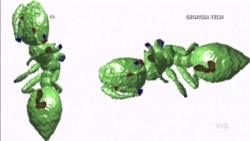Scientists have always been fascinated with the high level of organization in ant societies -- from building life-saving rafts during floods to the way colonies choose their next queen. New technology has helped advance researchers' understanding, but there is still a lot to be discovered.
Fire ants living in Brazilian forests are perfectly adapted to an environment prone to flooding. To save themselves from drowning, they lock their legs together, creating floating rafts, up to 20 centimeters wide.
According to mechanical engineer David Hu, ants know how to interlock tightly.
“If you can imagine you have a hundred ants, which means 600 legs. Ninety-nine percent of those legs will be connected to a neighbor so they're very, very good at maintaining that network,” he said
To discover the secret of their engineering, Hu and his colleagues at the Georgia Institute of Technology froze ant rafts and then analyzed them with a CT scanner.
They found out that larger ants serve as hubs to which smaller ants hold, forming pockets of air that keep them afloat.
Scientists say small robots or advanced materials that can configure themselves could be programmed in a similar way, working toward a shared goal.
At North Carolina State University, researchers study how Indian jumping ants choose the leader of the colony when they lose their queen.
Researcher Clint Penick says ordinary worker ants, which are all females, start tournament-style battles. After color-coding the ants for easier observation, Penick's team noticed that some workers became physically more dominant, and that triggered the release of certain hormones.
“Within a matter of days what we see is changes in dopamine in the brain that we think are linked to the reproduction that starts in these workers,” he said.
Soon, the winning ant starts developing ovaries for the production of eggs while its brain decreases in size, devoting all its energy to reproduction. It begins standing taller and its life span becomes three times longer.
Scientists say this behavior and the release of neural hormones are prompted by genetic instructions. They say these new findings may help researchers better understand the correlation between hormones and genes in humans.
Fire ants living in Brazilian forests are perfectly adapted to an environment prone to flooding. To save themselves from drowning, they lock their legs together, creating floating rafts, up to 20 centimeters wide.
According to mechanical engineer David Hu, ants know how to interlock tightly.
“If you can imagine you have a hundred ants, which means 600 legs. Ninety-nine percent of those legs will be connected to a neighbor so they're very, very good at maintaining that network,” he said
To discover the secret of their engineering, Hu and his colleagues at the Georgia Institute of Technology froze ant rafts and then analyzed them with a CT scanner.
They found out that larger ants serve as hubs to which smaller ants hold, forming pockets of air that keep them afloat.
Scientists say small robots or advanced materials that can configure themselves could be programmed in a similar way, working toward a shared goal.
At North Carolina State University, researchers study how Indian jumping ants choose the leader of the colony when they lose their queen.
Researcher Clint Penick says ordinary worker ants, which are all females, start tournament-style battles. After color-coding the ants for easier observation, Penick's team noticed that some workers became physically more dominant, and that triggered the release of certain hormones.
“Within a matter of days what we see is changes in dopamine in the brain that we think are linked to the reproduction that starts in these workers,” he said.
Soon, the winning ant starts developing ovaries for the production of eggs while its brain decreases in size, devoting all its energy to reproduction. It begins standing taller and its life span becomes three times longer.
Scientists say this behavior and the release of neural hormones are prompted by genetic instructions. They say these new findings may help researchers better understand the correlation between hormones and genes in humans.









